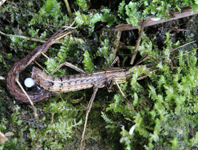Abstract
Cricket mating behavior reflects different strategies developed by sexual selection throughout evolutionary time. To our knowledge, only one species of the Neotropical cricket Trigonidiinae had its mating behavior studied so far. Here we expand this knowledge by describing the mating behavior of Cranistus colliurides Stål, 1861, a cricket commonly found in bushes and grasses along open fields or the forest edge. Adult crickets were collected in the municipality of Capão do Leão, State of Rio Grande do Sul, Brazil. Trials were carried out in laboratory to characterize the mating sequence. We quantified elapsed time of each behavioral sequence and discussed its implications in the observed mating behavior. The males of C. colliurides attracted females by means of a continuous trill, and receptive female triggers the beginning of the courtship through antennation. During courtship, copulation and post-copulatory actions, males showed a complex communication system based on information send to female by substrate vibration and an elaborated repertoire composed by calling, courtship and post-copulatory song. The mating behavior here described reveals divergence between related species hitherto studied which give us clues to understand how the sexual selection shaped the complex behaviors exhibited by Trigonidiinae crickets presently.
References
Alexander, R.D. (1962) Evolutionary change in cricket acoustical communication. Evolution, 16 (4), 443–467.
https://doi.org/10.1111/j.1558-5646.1962.tb03236.x
Alexander, R.D. & Otte, D. (1967a) The evolution of genitalia and mating behavior in crickets (Gryllidae) and other Orthoptera. Miscellaneous Publications Museum of Zoology, 133, 1–62.
Alexander R.D. & Otte, D. (1967b) Cannibalism during copulation in brown bush cricket Hapithus agitator (Gryllidae). Florida Entomologist, 50 (2), 79–87.
https://doi.org/10.2307/3493615
Altmann, J. (1974) Observational study of behavior: sampling methods. Behaviour, 49 (3‒4), 227‒266.
https://doi.org/10.1163/156853974X00534
Balakrishnan, R. & Pollack, G. (1997) The role of antennal sensory cues in female responses to courting males in the cricket Teleogryllus oceanicus. Journal of Experimental Biology, 200 (3), 511–522.
Bell, P.D. (1980) Multimodal communication by the black-horned tree cricket, Oecanthus nigricornis (Walker) (Orthoptera: Gryllidae). Canadian Journal of Zoology, 58 (10), 1861‒1868.
https://doi.org/10.1139/z80-254
deCarvalho, T.N. & Shaw, K.L. (2005) Nuptial feeding of spermless spermatophores in the Hawaiian swordtail cricket, Laupala pacifica (Gryllidae: Triginodiinae). Naturwissenschaften, 92 (10), 483–487.
https://doi.org/10.1007/s00114-005-0023-8
deCarvalho T.N. & Shaw K.L. (2010a) Elaborate courtship enhances sperm transfer in the Hawaiian swordtail cricket, Laupala cerasina. Animal Behaviour, 79 (4), 819–826.
https://doi.org/10.1016/j.anbehav.2009.12.017
deCarvalho, T.N. & Shaw, K.L. (2010b) Divergence of courtship and mating behaviors among endemic Hawaiian swordtail crickets. Behaviour, 147 (4), 479–504.
https://doi.org/10.1163/000579509X12586249027577
Evans, A.R. (1988) Mating systems and reproductive strategies in three australian gryllid crickets: Bobilla victoriae Otte, Balamara gidya Otte and Teleogryllus commodus (Walker) (Orthoptera: Gryllidae: Nemobiinae; Trigonidiinae; Gryllinae). Ethology, 78 (1), 21–52.
https://doi.org/10.1111/j.1439-0310.1988.tb00218.x
Frankino, W.A. & Sakaluk, S.K. (1994) Post-copulatory mate guarding delays promiscuous mating by female decorated crickets. Animal behavior, 48 (6), 1479–1481.
https://doi.org/10.1006/anbe.1994.1389
Funk, D.H. (1989) The mating of tree crickets. Scientific American, 261 (2), 50–59.
https://doi.org/10.1038/scientificamerican0889-50
Funk, D.H. (2016) Mating behavior of Phyllopalpus pulchellus Uhler (Orthoptera: Gryllidae: Trigonidiinae). Journal of orthoptera research, 25 (1), 7–13.
https://doi.org/10.1665/034.025.0103
Gershman, S.N., Mitchell, C., Sakaluk, S.K. & Hunt, J. (2012) Biting off more than you can chew: sexual selection on the free amino acid composition of the spermatophylax in decorated crickets. Proceedings of the Royal Society B: Biological Science, 279 (1738), 2531–2538.
https://doi.org/10.1098/rspb.2011.2592
Greco-Spíngola, S., Serra, W.S. & Lorier, E. (2016) Primer registro de Cranistus colliurides Stål, 1861 (Grylloidea, Trigonidiidae, Trigonidiinae) para Uruguay. Boletín de la Sociedad Zoológica del Uruguay, 25 (1), 66–71. [in Spanish]
Hockman, L.R. & Vahed, K. (1997) The function of mating guarding in a field cricket (Orthoptera: Gryllidae; Teleogryllus natalensis Otte and Cade). Journal of insect behavior, 10 (2), 247–256.
https://doi.org/10.1007/BF02765557
Loher, W. & Rence, B. (1978) The mating behavior of Teleogryllus commodus (Walker) and its central and peripheral control. Ethology, 46 (3), 225–259.
https://doi.org/10.1111/j.1439-0310.1978.tb01447.x
Martins, L.D.P., Redü, D.R., Oliveira, G.L.D. & Zefa, E. (2012) Recognition characters and new records of two species of Phylloscyrtini (Orthoptera, Gryllidae, Trigonidiinae) from southern Brazil. Iheringia. Série Zoologia, 102 (1), 95–98.
https://doi.org/10.1590/S0073-47212012000100013
Mays, D.L. (1971) Mating Behavior of Nemobiine Crickets: Hygronemobius, Nemobius, and Pteronemobius (Orthoptera: Gryllidae). Florida Entomologist, 54 (2), 113–126.
https://doi.org/10.2307/3493557
Prado, R. (2006) Reproductive behavior of Eidmanacris corumbatai Garcia (Orthoptera: Phalangopsidae). Neotropical Entomology, 35 (4), 452–457.
https://doi.org/10.1590/S1519-566X2006000400005
Preston-Mafham, K. (2000) Diurnal mating behaviour of a Nisitrus sp. cricket (Orthoptera: Gryllidae) from Sumatra. Journal of Natural History, 34 (12), 2241–2250.
https://doi.org/10.1080/002229300750037884
Shaw, K.L. & Khine, A.H. (2004) Courtship behavior in the Hawaiian cricket Laupala cerasina: males provide spermless spermatophores as nuptial gifts. Ethology, 110 (2), 81‒95.
https://doi.org/10.1046/j.1439-0310.2003.00946.x
Spooner, J.D. (1972) Courtship in Falcicula hebardi (Orthoptera: Gryllidae, Trigonidiinae). Annals of the Entomological Society of America, 65 (6), 1419–1419.
https://doi.org/10.1093/aesa/65.6.1419
Stoffer, B. & Walker, S.E. (2012) The use of multimodal communication in mate choice decisions by female house crickets, Acheta domesticus. Animal Behaviour, 83 (4), 1131–1138.
https://doi.org/10.1016/j.anbehav.2012.02.006
Walker, T.J. (1978) Post-copulatory behavior of the two-spotted tree cricket, Neoxabea bipunctata. Florida Entomologist, 61 (1), 39–40.
https://doi.org/10.2307/3494433
Zefa, E., Martins, L.D.P. & Szinwelski, N. (2008) Complex mating behavior in Adelosgryllus rubricephalus (Orthoptera, Phalangopsidae, Grylloidea). Iheringia. Série Zoologia, 98 (3), 325–328.
https://doi.org/10.1590/S0073-47212008000300006
Zefa, E., Oliveira, G.L., Redü, D.R. & Martins, L.P. (2012) Calling song of two sympatric species of cricket Phylloscyrtini (Orthoptera, Gryllidae, Trigonidiinae). Ethology Ecology & Evolution, 25 (1), 21–27.

